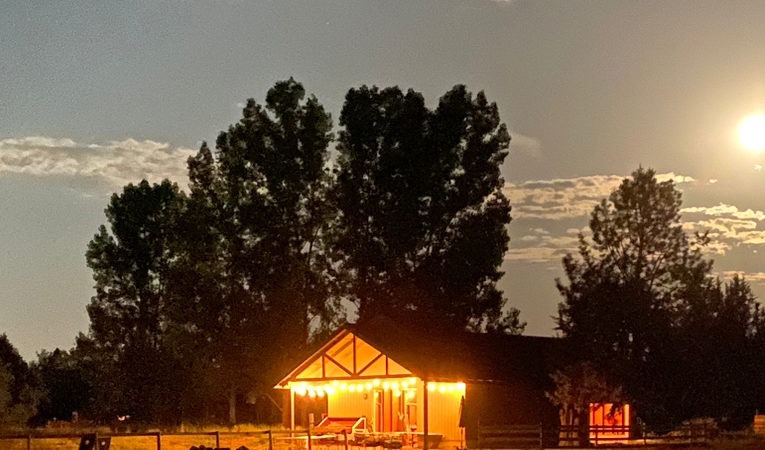It’s early morning on a crisp October day on the small farm in Central Oregon that I now call home. I gaze through the window at the ponderosa pines that border the serene pasture. Our neighbor will swing by this morning to bring us some fresh bread he just made. I make coffee and put on my warm farm clothes, which include sturdy pants, jacket, boots, and a hat. My husband, Kyle, and I grab our coffee and head outside, stopping first to watch the spectacle of robins hopping around in the dry grass. Today, we continue tackling our task list and chores – cleaning up the barn in preparation for our upcoming neighborhood gathering, checking on the garlic we planted, and turning the compost. Later, another neighbor will be bringing loads of fallen leaves from her property; we’ll shred and use them to cover our vegetable beds for the winter months. We may also have a visit from our French neighbors, who also have a small farm nearby, walking their dog and stopping to chat with us. Amid this rural routine, I will listen at some point in the day to one of my favorite podcasts. Later in the afternoon, by the wood-burning stove, I’ll delve into art projects and my permaculture design certificate course.
And to think that a few months ago, I was living in Silicon Valley.
First pumpkin harvest. Kyle and I grew them for our neighbors, and we gave them away on our stand and during the Halloween party we had with our neighbors at our barn.
In the summer of 2019, I learned about the polycrisis – an intricate existential threat beyond just climate change. This threat is a convergence of many crises, each catastrophic and leading to a potential systemic collapse. The crises are interconnected, spanning ecology, energy, economy, and equality, encompassing habitat destruction, mass extinction, land and human exploitation, pollution, soil depletion, sea level rise, and overshoot. Climate change, the most visible ambassador of our polycrisis, is merely a symptom of a civilization at war with the living world, transforming planetary resources into waste using cheap and abundant (for now) fossil fuels to do it. Transitioning to renewable energy alone will not be sufficient – we must fundamentally transform our existence on Earth and how we operate as a society if we are to survive.
Although I have always been environmentally conscious, keeping myself informed daily, and having come from a family of scientists, I was caught off guard by this newfound realization about the massive, interconnected crisis we face. I felt an urgent need to seek more (and more reputable) information amid pervasive greenwashing and misinformation – to educate myself better. I had to know more about this threat. Yet with each new piece of information I acquired, the enormity of the crisis filled me with more terror, haunted by concerns for my children’s futures. Overwhelmed by eco-anxiety and solastalgia—anguish from the biosphere’s loss—I grappled with profound grief. Immersed in podcasts and videos, understanding became consuming, creating a detachment from everyday conversations.
Knowing about the polycrises altered everything, leading to isolation as I grappled with the urgency of spreading the message about the existential threat to the people around me. The urgency to share the severity of the situation felt overwhelming; pivotal times dawned, accompanied by a sense of guilt. On the advice from experts to engage people around me to prepare for a potential collapse, I tried many times, in my own imperfect ways, to transfer some of my newfound knowledge to the people around me with the hope that they might suddenly see what I have seen, yet I had less than limited success. My efforts to do so were always met with resistance or blind faith in a future technology that would magically appear and save us. The challenge of breaking through this optimism proved both daunting and disheartening, and my frustration grew.
I found myself at a crossroads – overwhelmed by the knowledge and fear of what we face, yet seemingly unable to do much about it and with no one listening to me. There were certainly some individual things that I could do. Like so many, I wanted to reduce my carbon footprint. I am already a vegetarian (I won’t go into how the simple act of eating vegetarian has enormous positive impacts on the environment). I resolved to limit my travel to family visits every few years. Yet I still felt isolated – that I was trying to solve a planetary problem with a few changes to my lifestyle. It was simply not enough. This frustration yielded a determination to take action, shifting from a paralyzing realization to a proactive mindset.
For my own sanity and need to discuss the issues at hand, I needed to connect with trustworthy and reputable outlets to discuss them and begin working with others on them. I discovered solace in the Millennium Alliance for Humanity and the Biosphere (MAHB), where a like-minded community acknowledged and embraced my fears instead of dismissing them. Joining as the art page’s editor brought a sense of fulfillment and connection, providing a platform to channel and share my apprehensions with others who comprehended the gravity of the situation.
Exponential (January 2020), Our House (January 2021), Slow Down (January 2022), Limits (February 2023)
Four art-specific installations made of objects and natural materials found on-site,
Desert Dairy Residency, Mojave Desert, California.
My art has always been a place for me to seek comfort, but it has also been an avenue for me to send a message and to draw awareness to things that deserve attention. Integrating my newfound knowledge of our existential threat was, therefore, a natural way for me to cope with this new awareness, channel my fear, and spread awareness using my strengths.
I embarked on an artist residency in the Mojave Desert, working on Exponential, a site-specific installation reflecting our unsustainable consumption and waste. With this mindset of sustainability and minimal waste, I decided to change my approach to my art, using industrial materials and objects found already on-site. I didn’t want to buy and be responsible for the production of more material for my installation. This deliberate choice of using materials found on-site became the methodology for my subsequent projects: Our House, Slow Down, and Limits. Not only did this make me feel empowered in some way to change my impact on the planet, but it also allowed me to send a message to others via my art that we need to pay more attention to our individual impacts. My message and path were taking shape.
The onset of COVID-19 brought a sudden end to any gallery exhibitions and to the contract-based art projects I had been doing with students in schools, but my motivation to continue doing art, doing something about our existential threat, and spreading awareness did not end. So I channeled my energy into the creation of a new online project that would become pivotal in my journey: “What’s Next for Earth.” It invited artists worldwide to participate in bi-monthly online art calls inspired by the Think Resilience course by Richard Heinberg (Post Carbon Institute), resulting in curated online exhibitions on the MAHB art page and project website. The project empowered me to feel I was doing something for my community (the artists) by giving them a new venue to expose their art. It also showed me that there was an opportunity to rally the community to action and get the word out about the polycrisis.
Down To Earth
Participatory site-specific installation, Gallery Route One, Point Reyes, CA and Art Downtown Gallery, San Rafael CA, 2023.
When the opportunity came my way for a new gallery exhibition, I seized the moment to embark on a large participatory installation project, “Down to Earth,” inspired by the 50th anniversary of Limits to Growth. Exhibited at two California galleries, the installation created a visualization of societal responses to our polycrisis and invited the public to provide input by writing and hanging their own thoughts and concerns directly on the installation. Subsequently, I worked on another project commissioned by the Post Carbon Institute for their report cover, Welcome to the Great Unravelling: Navigating the Polycrisis of Environmental and Social Breakdown, to create another visualization based on the climate stripes.
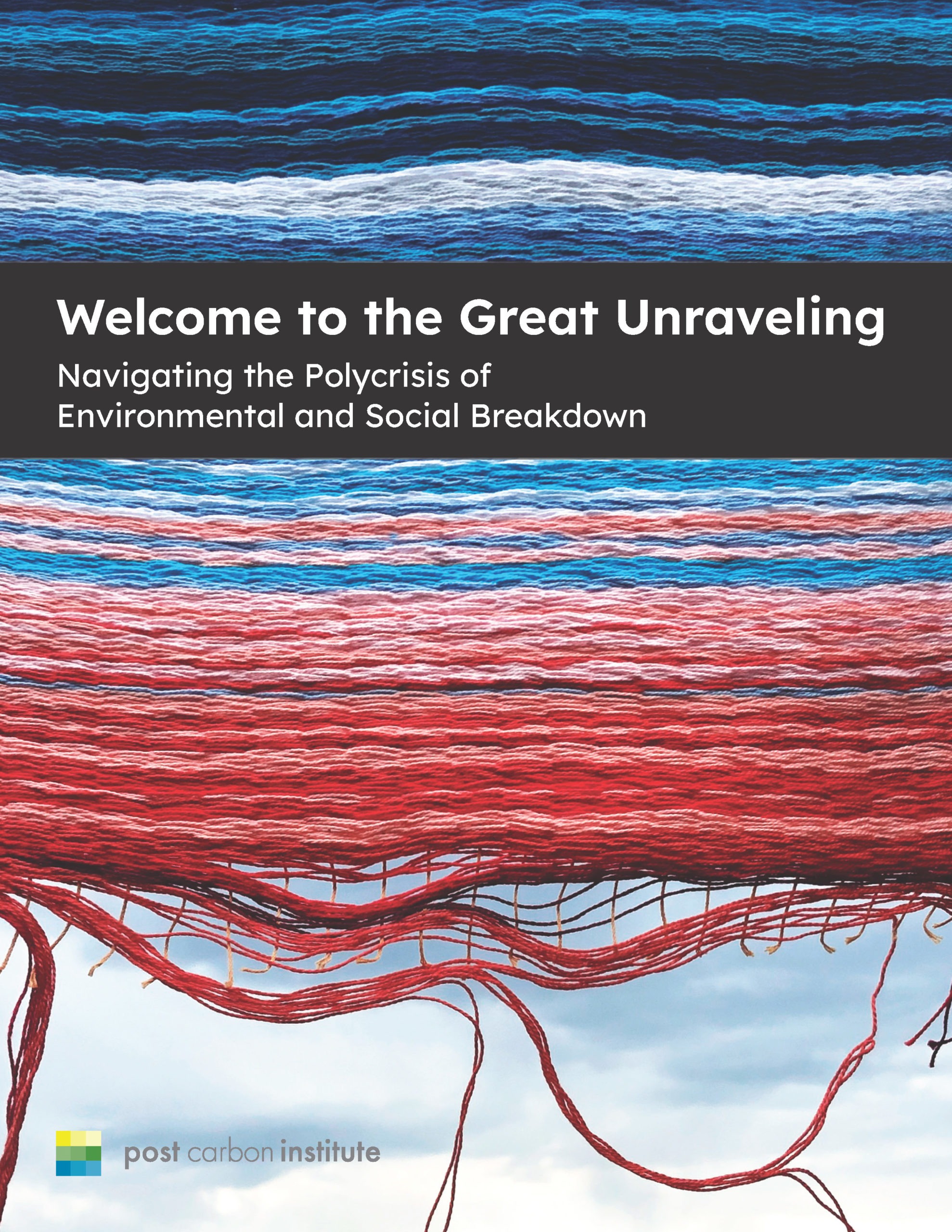
The cover of Post Carbon Institute’s recent report, Welcome to the Great Unravelling: Navigating the Polycrisis of Environmental and Social Breakdown.
With the relentless escalation of climate-related tragedies around the world, I began thinking more deeply about how to achieve more resilience in my personal life and in the community around me. The unbroken chain of global catastrophic events, exacerbated by COVID-19, is increasingly affecting and disrupting communities and showing us the fragility of the designs of our global systems. Despite being mostly invisible, the impacts of the 6th extinction and imminent resource depletion loom large. Our systems are predicated on stability – that things will continue to function daily, yet that’s not what we face ahead of us.

The barn at Authentique Artfarm, where we hope to have many community gatherings and art workshops.
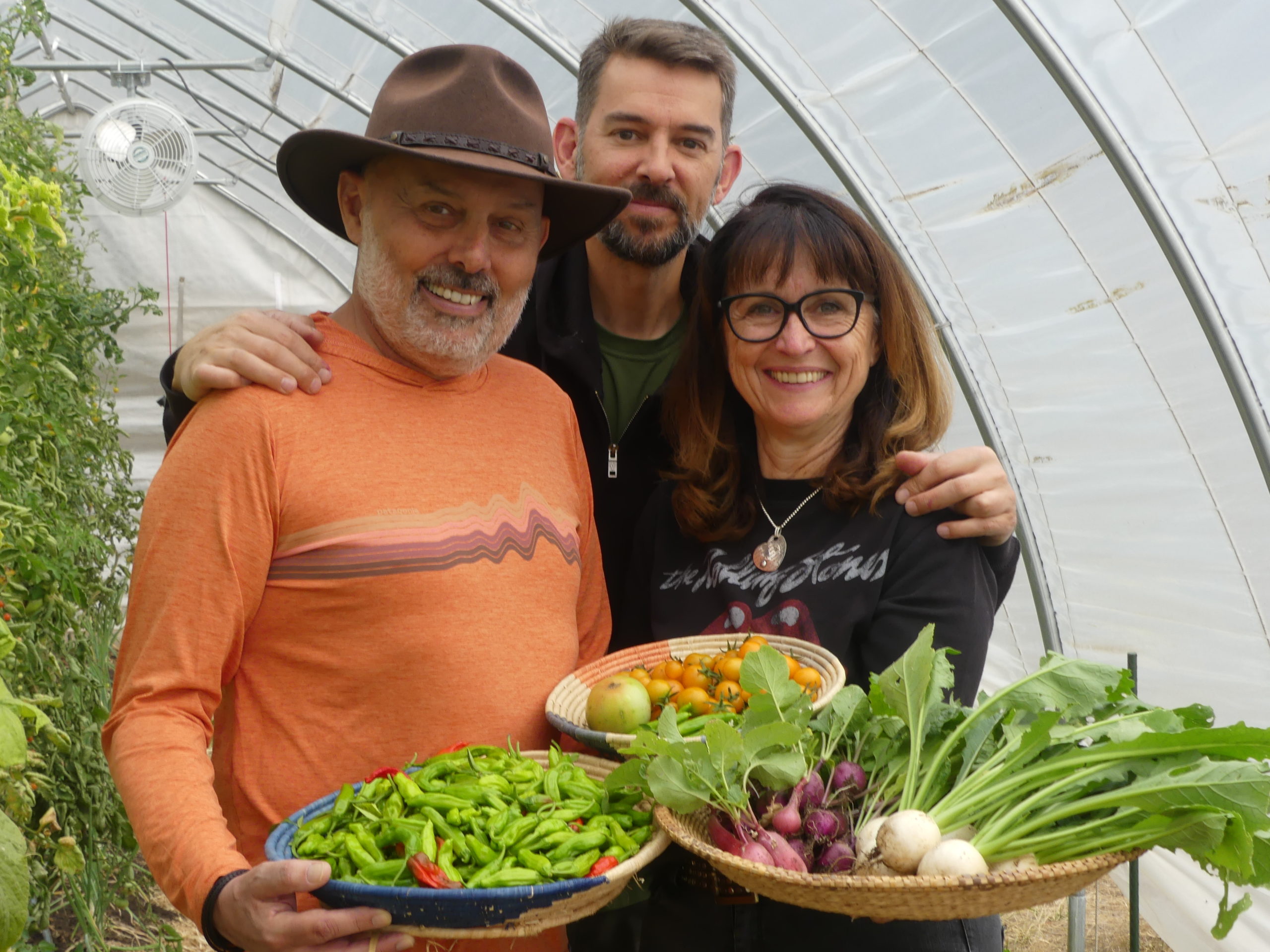
Enjoying harvesting with friends and neighbors, and prepare meals together.
The realization that drastic changes are imperative becomes more apparent as we navigate uncharted territories, highlighting the urgency for proactive community-driven initiatives. In October 2020, Southern France’s Vallee de la Roya, the cherished home of my grandparents where I spent my childhood vacations, was devastated by a major storm named “Alex”, which caused unprecedented flooding and destruction and claimed lives. Each year, wildfires intensify, and 2023 marked the hottest recorded year. Scientists declare the demise of the stable climate conducive to human civilization. Inadequate government responses underscore the need for communities to self-educate and prepare for forthcoming shocks.
COVID-19 taught my husband and me something about community resilience that planted the seed of the next big change in our lives to help reconcile my growing feeling that I need to do something about resilience in my community. When COVID-19 hit, Kyle and I experienced firsthand what the Think Resilience course demonstrates: one of the best ways we can make an impact is at our community level.
During the pandemic, we began growing and offering surplus vegetable seedlings from our backyard garden to our community. People were feeling like us – frustrated at supply chain fragility and feeling that they needed some measure of control over their situation. Word of our seedling giveaway spread like wildfire, and it was ironically during this horrible pandemic that we met more people in our community than in the years before, many of whom became new friends. We also began concertedly growing surplus vegetables with the intent of providing a regular supply to the people around us. We knew, then and there, that we had found a new way to make a difference by doing something we were good at and enjoyed doing.
It was through this lesson that Kyle and I, yearning for a profound change and more resilience and impact, left our home in Silicon Valley to seek a closer connection with nature and a more resilient life. It was a change that took time. After searching for almost two years, we purchased a small farm in Central Oregon that we named Authentique Artfarm. The name is inspired by the French book “Manon Des Sources” by Marcel Pagnol. Like the protagonist in the book, we, too, came to the countryside to “cultivate what is authentic”, aligning with our (and his) quest for more genuine daily living. Living deliberately, we embrace a slower pace, fostering connections with neighbors through morning coffees and shared resources.
Have I conquered my eco-anxiety and fear of the planetary disaster we face? No. Fear can be crippling, but it can also be an incredible motivator. I do not regret that anxiety. It awakened me and prompted me to action, and it continues to do so daily. The anxiety is a reminder that there is work to be done and changes to be made.
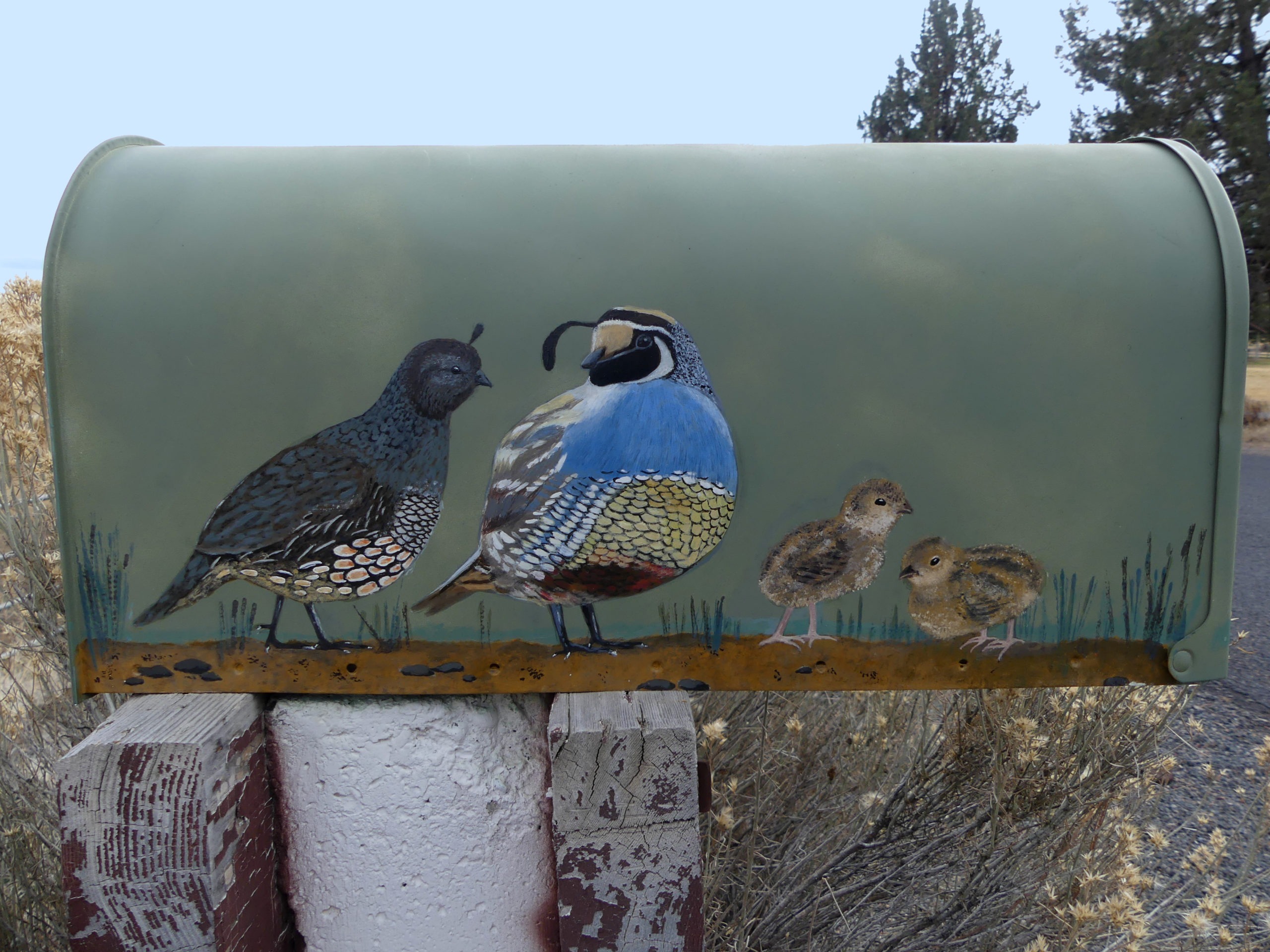
The newly painted mailbox at Authentique Artfarm is a collaborative piece between my youngest son and me.
Despite my sleepless nights, the knowledge gained through my constant quest for understanding and the connections formed with organizations like MAHB, Post Carbon Institute, and Deep Transformation Network have been invaluable to me. Taking action, engaging the community, and instigating projects like “What’s Next for Earth” have made me feel more connected and helped me to foster new and lasting friendships with people who share my concerns. Through participatory installations, I’ve sought to amplify awareness about our predicament and encourage reflection on possible actions. And the journey and anxiety have led Kyle and me to a pivotal decision to create Authentique Artfarm with a focus on resilience and being more connected to nature in our daily lives.
As we navigate the path ahead of us, there’s a long list of goals and tasks on our list to strengthen our community, support our friends and neighbors, and create a thriving space where our crops and the people around us can flourish and benefit from the resilience we are contributing. It is a journey, not a destination, and this journey provides us with daily feedback that we are doing something to make a difference. This is the kind of growth we need right now. It aligns with our commitment to cultivating food and fostering creativity and resilience in our community, addressing crucial needs in these challenging times.
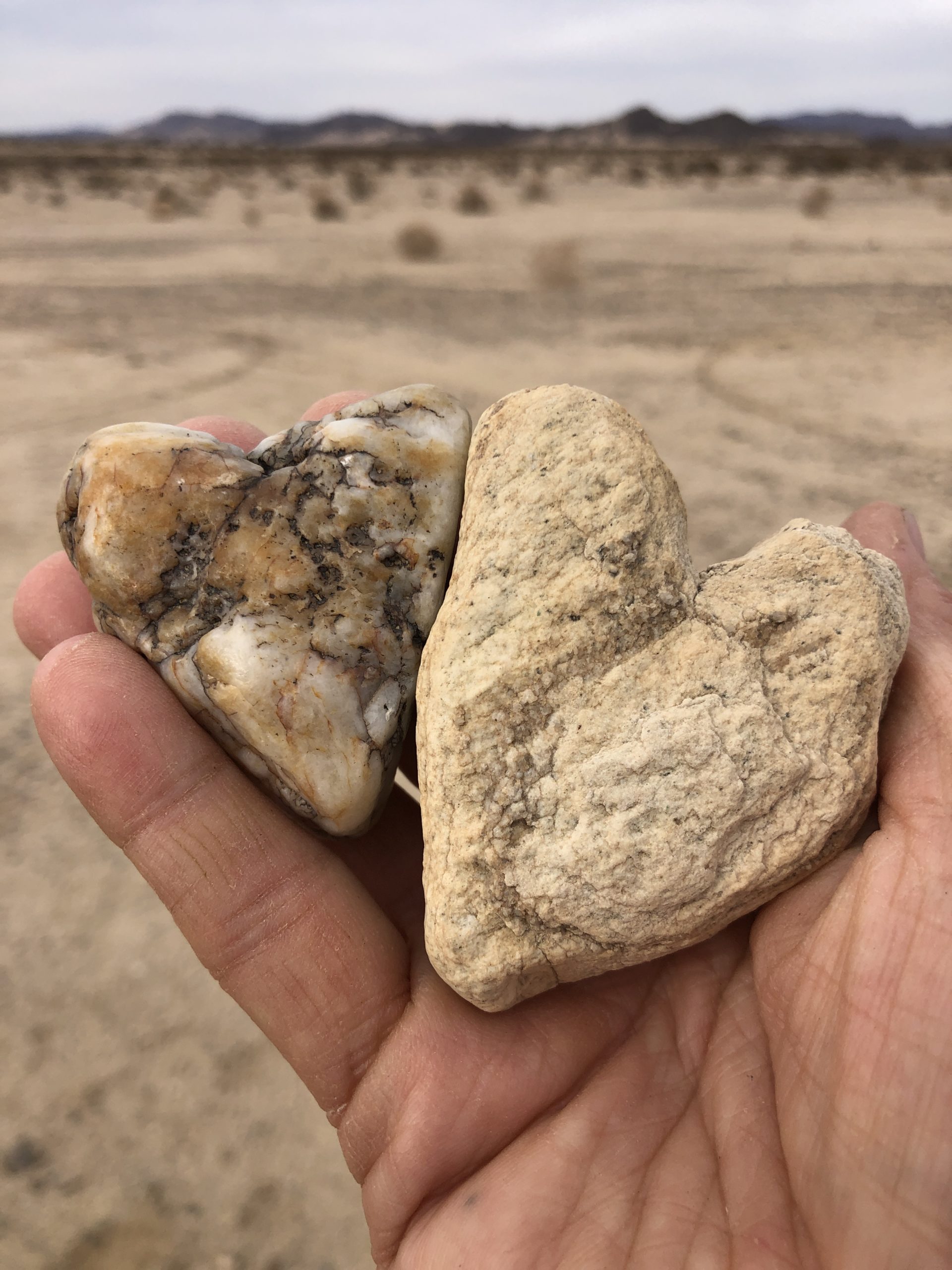
Two heart-shaped rocks found during my last artist residency in the Mojave Desert in January 2023.
Resources
– What’s Next for Earth on Instagram
– What’s Next for Earth on MAHB
– Artists and Creatives Group on the Deep Transformation Network
– The Great Simplification with Nate Hagens (podcast)
– Reality 101 – Nate Hagens (free online course)
– The Great Simplification (short film 32 min)
– Richard Heinberg’s Think Resilience (free online course)
– Welcome to the Great Unraveling by Post Carbon Institute (report)
– Planet Critical with Rachel Donald (podcast)
– Collapse Musing (website)
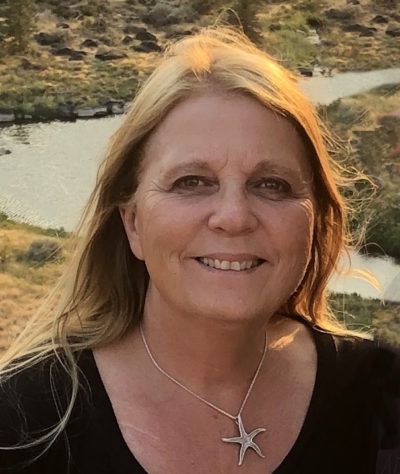 Michele Guieu is an environmental artist and educator, passionate about exploring resilience in the face of our current civilizational challenges. She has Recently settled in Central Oregon to establish a small vegetable farm. Michele holds a Permaculture Certificate from Oregon State University’s course by Andrew Millison.
Michele Guieu is an environmental artist and educator, passionate about exploring resilience in the face of our current civilizational challenges. She has Recently settled in Central Oregon to establish a small vegetable farm. Michele holds a Permaculture Certificate from Oregon State University’s course by Andrew Millison.
She created and curates the ongoing art project, “What’s Next for Earth,” based on the Think Resilience course developed by Richard Heinberg of the Post Carbon Institute.
Michele co-hosts the Artists and Creatives Group with Christine Conklin as part of the Deep Transformation Network, a platform created by Jeremy Lent.
Michele is the Art Editor at MAHB, contributing to the intersection of art and environmental advocacy.
You can explore Michele’s website, discover the What’s Next for Earth’s Art Project and delve into the Artists and Creatives group within the Deep Transformation Network.

